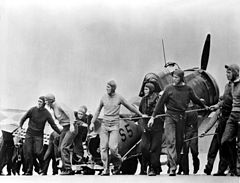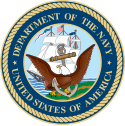Bruno Gaido
 Przecięty skrzydłem bombowca G3M kadłub SBD | |
| Data i miejsce urodzenia | 1916 |
|---|---|
| Data i miejsce śmierci | 15 czerwca 1942 |
| Przebieg służby | |
| Lata służby | 1940–1942 |
| Siły zbrojne | |
| Jednostki | |
| Główne wojny i bitwy | Wojna na Pacyfiku †: |
| Odznaczenia | |
Bruno Peter Gaido (ur. 1916 w Staunton, zm. 15 czerwca 1942 na Pacyfiku) – amerykański lotnik, żołnierz marynarki wojennej, członek załogi – strzelec, obserwator – bombowca nurkującego Douglas SBD Dauntless eskadry VS-6, uczestnik rajdu na wyspy Marshalla i Gilberta oraz bitwy pod Midway. Wsławiony zestrzeleniem z karabinu maszynowego tylnego strzelca stojącego na pokładzie USS „Enterprise” bombowca SBD Dauntless, zmierzającego do ataku samobójczego bombowca Mitsubishi G3M. Prawdopodobnie zestrzelony podczas powrotu z ataku VS-6 na japońskie lotniskowce podczas bitwy pod Midway, zginął jako jeniec wojenny zamordowany przez Japończyków z niszczyciela „Makigumo”.
Bibliografia
- Bruno Peter Gaido. [dostęp 2021-03-06].
- Aviation Machinist's Mate 1st Class Bruno Gaido. Naval History and Heritage Command. [dostęp 2021-03-06]. (ang.).
- Toughness—Aviation Machinist Mate 1st Class Bruno Peter Gaido. Naval History and Heritage Command. [dostęp 2021-03-06]. (ang.).
Media użyte na tej stronie
Baretka amerykańskiego odznaczenia Purple Heart.
Ribbon for the World War II Victory Medal awarded by the United States Department of Defense.
Ribbon for the Asiatic-Pacific Campaign Medal awarded by the United States Department of Defense.
Baretka amerykańskiego odznaczenia Purple Heart.
Ribbon from the Distinguished Flying Cross (United States) awarded by the United States Department of Defense.
A damaged U.S. Navy Douglas SBD-2 Dauntless of bombing squadron VB-6 on the flight deck of the aircraft carrier USS Enterprise (CV-6), 1 February 1942. Withdrawing after launching an attack against Kwajalein, Enterprise was attacked by five Japanese Mitsubishi G4M "Betty" land-based bombers. Manning the flexible rear machine gun on an SBD-2 of bombing squadron VB-6, AMM Bruno Gaido attempted to help fight off the attackers. The wing of one of the disabled bombers severed the tail of Gaido's Dauntless, spreading burning gasoline across the deck before crashing into the ocean. For his heroism, Gaido was promoted and assigned duty as an aircrewman. Gaido was shot down with his pilot Ensign Frank W. O'Flaherty on 4 June 1942 and later picked up by the Japanese destroyer Makigumo. Circa 8-9 June both were murdered as they were tied to water-filled gasoline drums and dumped overboard.
Ribbon for the American Defense Service Medal awarded by the United States Department of Defense.
*Description: On a circular background of fair sky and moderate sea with land in sinister base, a tri-mast square rigged ship under way before a fair breeze with after top-sail furled, commission pennant atop the foremast, National Ensign atop the main, and the commodore's flag atop the mizzen. In front of the ship a luce-type anchor inclined slightly bendwise with the crown resting on the land and, in front of the shank and in back of the dexter fluke, an American bald eagle rising to sinister regarding to dexter, one foot on the ground, the other resting on the anchor near the shank; all in proper colors. The whole within a blue annulet bearing the inscription "Department of the Navy" at the top and "United States of America" at the bottom, separated on each side by a mullet and within a rim in the form of a rope; inscription, rope, mullet, and edges of annulet all gold. *Background: The policy for use of the Navy seal and emblem is contained in SECNAV Instr 5030.4 and SECNAV Instr 5030.6. The seal design was approved by the President of the United States by Executive Order 10736 dated October 23, 1957. Request for use of the Navy emblem should be submitted in writing to Defense Printing Service, ATTN: DPSMO, 8725 John Kingman Rd Suite 3239, Fort Belvoir, VA 22060-6220. The telephone number is (703) 767-4218. 1879 version here: http://etc.usf.edu/clipart/54900/54985/54985_seal_navy.htm
Ribbon for the American Campaign Medal awarded by the United States Department of Defense.









